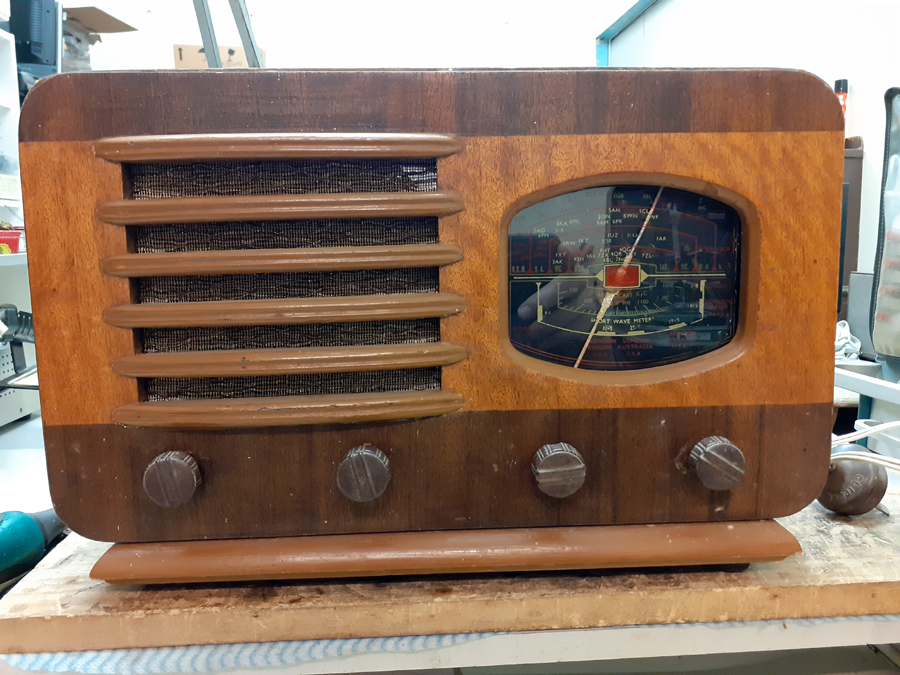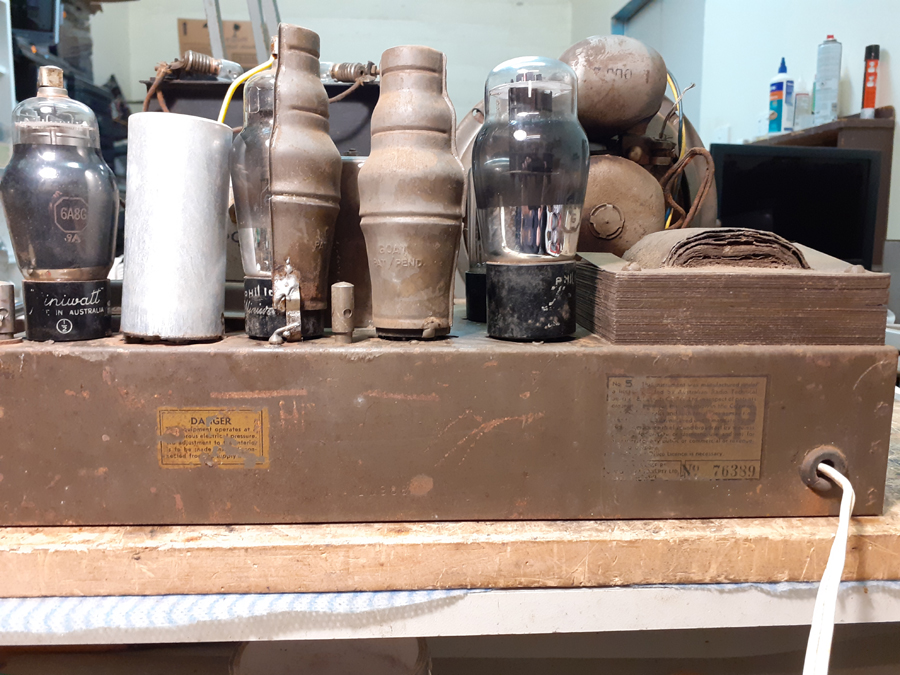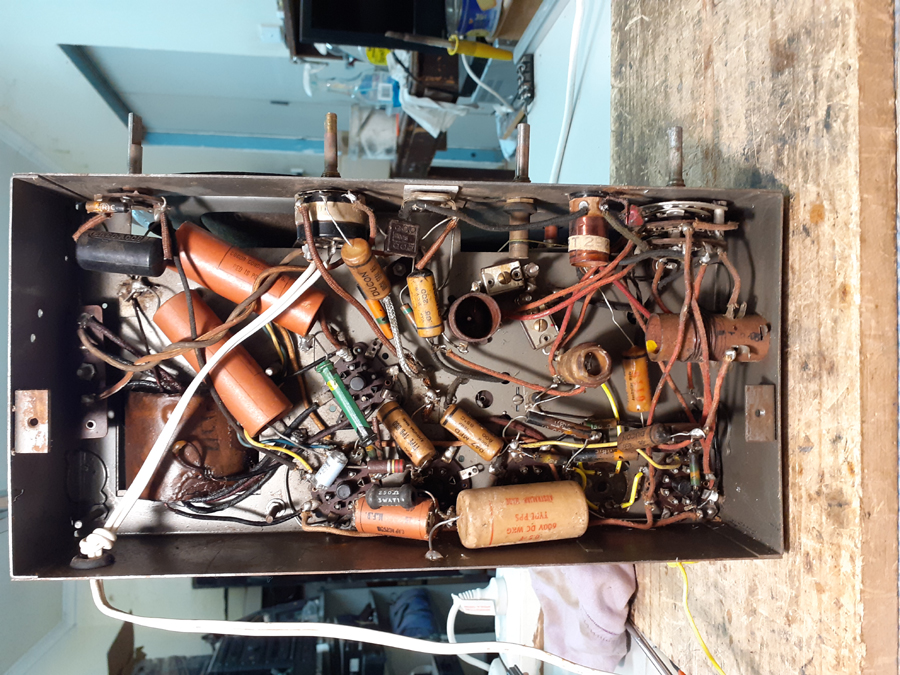Tech Talk
Forum home - Go back to Tech talk
|
Radio Identification
|
|
|
Return to top of page · Post #: 1 · Written at 1:26:09 PM on 20 January 2020.
|
|

|
Location: Nildottie, SA
Member since 7 April 2018 Member #: 2236 Postcount: 43 |
|
Hello Everybody. I have acquired this wooden mantle radio.    |
|
|
Return to top of page · Post #: 2 · Written at 4:03:05 PM on 20 January 2020.
|
|
|
|
Administrator
Location: Naremburn, NSW
Member since 15 November 2005 Member #: 1 Postcount: 7577 |
|
I don't think it is an Astor although it could have been made by them, as they and other large companies made radios for smaller ones. The dial glass is shaped like STC but this isn't an STC either. ‾‾‾‾‾‾‾‾‾‾‾‾‾‾‾‾‾‾‾‾‾‾‾‾‾‾‾‾‾‾‾‾‾‾‾‾‾‾‾‾‾‾‾‾‾‾‾‾‾‾‾‾‾‾‾‾‾‾‾‾‾‾‾‾‾‾‾‾ A valve a day keeps the transistor away... |
|
|
Return to top of page · Post #: 3 · Written at 4:26:15 PM on 20 January 2020.
|
|
|
|
Location: Wangaratta, VIC
Member since 21 February 2009 Member #: 438 Postcount: 5646 |
|
Its a SW/BC with a 6A8 so that would likely put it around 1937 as 6V6 did not arrive until 11/36. 6J8 superseded 6A8 in SW sets after it was brought in 2/38. There was a bit of reversion to non octal tubes during the War, so that's the era I would be looking. |
|
|
Return to top of page · Post #: 4 · Written at 5:02:35 PM on 20 January 2020.
|
|

|
Location: Nildottie, SA
Member since 7 April 2018 Member #: 2236 Postcount: 43 |
|
Thank you. That narrows the search down. I did look for a five valve with a 6A8G but there are many.. |
|
|
Return to top of page · Post #: 5 · Written at 6:47:47 PM on 20 January 2020.
|
|
|
|
Location: Melbourne, VIC
Member since 20 September 2011 Member #: 1009 Postcount: 1257 |
|
It does look Astorish. Maybe a National by Radio Corp?? |
|
|
Return to top of page · Post #: 6 · Written at 9:03:39 PM on 20 January 2020.
|
|
|
|
Location: Wangaratta, VIC
Member since 21 February 2009 Member #: 438 Postcount: 5646 |
|
Astor did tend to use the worst quality rubber covered wire of the four grades apparently available. Kriesler & I think Astor did do as I do and put a dob of paint on each node to show it had been inspected. Tasma seemed to like to use the minimum scanting on some of their heater wire and it had a habit of disintegrating the closer it got to the transformer. |
|
|
Return to top of page · Post #: 7 · Written at 1:15:49 PM on 21 January 2020.
|
|
|
|
Location: Toongabbie, NSW
Member since 19 November 2015 Member #: 1828 Postcount: 1385 |
|
Nice little set, be a joy to work on. |
|
|
Return to top of page · Post #: 8 · Written at 1:17:27 PM on 21 January 2020.
|
|
|
|
Location: Belrose, NSW
Member since 31 December 2015 Member #: 1844 Postcount: 2658 |
|
I'm tipping Tasma, and built in the early 40s, i.e. during WW2 from the ARTS&P transfer. |
|
|
Return to top of page · Post #: 9 · Written at 8:55:33 PM on 21 January 2020.
|
|
|
|
Location: Wangaratta, VIC
Member since 21 February 2009 Member #: 438 Postcount: 5646 |
|
As that is SW, I would be tempted to reverse engineer the mixer tube and see what the resistors are relative to a Tasma 710 or an earlier model. |
|
|
Return to top of page · Post #: 10 · Written at 1:24:00 AM on 22 January 2020.
|
|
|
|
Location: Hill Top, NSW
Member since 18 September 2015 Member #: 1801 Postcount: 2230 |
|
The chassis colour makes it look a bit like a Peter Pan or equivalent. Apart from that I have no clue. |
|
|
Return to top of page · Post #: 11 · Written at 9:51:51 AM on 22 January 2020.
|
|
|
|
Location: Wangaratta, VIC
Member since 21 February 2009 Member #: 438 Postcount: 5646 |
|
The point I would make here is that most of the sets of that era used a very tight range of valves and save for a few minor variances, all circuit wise followed the same plot. I have never let the absence of a circuit throw me. |
|
|
Return to top of page · Post #: 12 · Written at 10:09:12 AM on 22 January 2020.
|
|

|
Location: Nildottie, SA
Member since 7 April 2018 Member #: 2236 Postcount: 43 |
|
The number stamped on the chassis is: A 11988. |
|
|
Return to top of page · Post #: 13 · Written at 8:36:14 PM on 22 January 2020.
|
|
|
|
Location: Sydney, NSW
Member since 28 January 2011 Member #: 823 Postcount: 6902 |
|
The chassis is almost army green. |
|
|
Return to top of page · Post #: 14 · Written at 9:41:15 PM on 22 January 2020.
|
|
|
|
Location: Wangaratta, VIC
Member since 21 February 2009 Member #: 438 Postcount: 5646 |
|
That is likely a subbed IF can: Two scenario's (1) it should have two slugs (2nd) its a top or bottom trimmer type is the top solid, or are there trimmers? |
|
|
Return to top of page · Post #: 15 · Written at 9:47:19 PM on 22 January 2020.
|
|
|
|
Location: Sydney, NSW
Member since 28 January 2011 Member #: 823 Postcount: 6902 |
|
MSP (Manufacturers Special Products) was a division of AWA that made components for other local radio and equipment manufacturers. |
|
|
You need to be a member to post comments on this forum.
|
|

Sign In

Vintage Radio and Television is proudly brought to you by an era where things were built with pride and made to last.
DISCLAIMER: Valve radios and televisions contain voltages that can deliver lethal shocks. You should not attempt to work on a valve radio or other electrical appliances unless you know exactly what you are doing and have gained some experience with electronics and working around high voltages. The owner, administrators and staff of Vintage Radio & Television will accept no liability for any damage, injury or loss of life that comes as a result of your use or mis-use of information on this website. Please read our Safety Warning before using this website.
WARNING: Under no circumstances should you ever apply power to a vintage radio, television or other electrical appliance you have acquired without first having it checked and serviced by an experienced person. Also, at no time should any appliance be connected to an electricity supply if the power cord is damaged. If in doubt, do not apply power.
Shintara - Keepin' It Real · VileSilencer - Maintain The Rage
